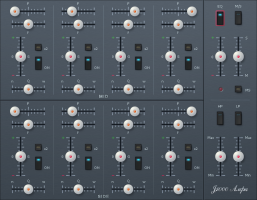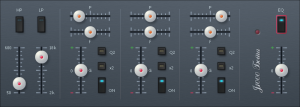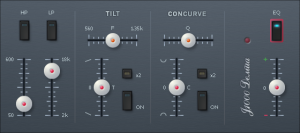J1000 Alpha is an equalizer made for fine tuning in post-production. The EQ separates stereo into mid and side signals and allows independent equalization over both signals. Each of two sections consists of four identical peak filters. The controls are classic F/G/Q similar to a fully-parametric equalizer. Gain range for each filters is +/- 3dB. Master section has high-pass and low-pass filters, input gain and stereo width faders. High-pass and low-pass filters have fixed frequencies and faders actually control filters’ steepness. Stereo width adjustment is done with two opposite filters so that the bass remains almost intact.
- Separate mid/side processing.
- 4 independent peak filters per channel.
- Standard parametric controls.
- Stereo width adjustment.
- HP and LP filters with adjustable steepness.
J1000 Beta is an EQ very similar in functionality to Alpha, but adapted to mixing. Its frequency faders work in exactly the same way. Gain range is increased to +/-6dB (12dB with x2), which is also modest compared to usual mixing equalizers. There is no fader to continually adjust Q factor, but you can choose from four bandwidth curves that cover most needs. High-pass and low-pass faders control frequency at which cutting occurs, which is traditional the way of controlling HP & LP filters. Their steepness is non-adjustable and it was selected to preserve natural sound as much as possible. If you need drastic EQ-ing this is not an adequate plug-in for the task. On other hand, if you want subtle tools for enhancing timbral properties of an instrument or voice rather than altering them beyond recognition Beta will suit just fine.
- 3 independent stereo filters.
- Standard parametric controls.
- Four Q factor values that cover most needs.
- HP and LP filters with adjustable frequency and moderate slopes.
J1000 Delta is a mixing EQ that shares the same HP/LP and output section as Beta. The obvious difference is the way Delta handles audio via Its tilt and concurve modules. Actually, they are just pairs of filters that are set to work in parallel. In the case of tilt when one filter goes up, other goes down. Since their central frequencies are far apart (at default they are 50Hz and 10.5kHz), it results in spectrum tilting. In case of concurve, which the name derives from convex/concave curve, both filters react the same way, so when you move [C] fader up the spectrum “smiles”, and when you move it down it “frowns”. Loudness difference is automatically compensated. Delta is suitable when you want to preserve the natural color of the instrument, optimize Its presence in the mix and, figuratively speaking, adjust Its brightness and contrast.
- Spectrum tilt control with variable center frequency.
- Spectrum concurve control with variable Q factor.
- HP and LP filters with adjustable frequency and moderate slopes.
J1000 Gamma is an equalizer intended primarily for mastering. It is based on Fletcher-Munson curve, allowing you to accent only the parts of audio spectrum where the ear is less sensitive and to lower the ones where ear is more sensitive. Six faders control gain amounts of six corresponding peak filters. Each filter has fixed Q factor and several selectable central frequencies, except for the last one (labelled F) which is permanently set at 12.8kHz. Master multiply fader controls the total amount of EQ-ing applied.
- Ear-friendly frequency response.
- 6 peak filters – 3 can only be boosted, 3 can only be cut.
- Several selectable frequencies per filter.
- Multiply fader controls total amount of EQ.
Viewers of this article also read...
-
 Rent-to-own Ozone 9 and Neutron 3 together on Splice
Splice has bundled iZotope’s latest software audio processors and offers them at a lower price through their rent-to-own program.
Rent-to-own Ozone 9 and Neutron 3 together on Splice
Splice has bundled iZotope’s latest software audio processors and offers them at a lower price through their rent-to-own program.
-
 Over 150 free software tools to make music
Making music with your computer when you don't have a penny is possible. And to prove our point here you have 150+ free software tools many of which don't have anything to envy their paid counterparts.
Over 150 free software tools to make music
Making music with your computer when you don't have a penny is possible. And to prove our point here you have 150+ free software tools many of which don't have anything to envy their paid counterparts.
-
 Over 150 free software tools to make music
Making music with your computer when you don't have a penny is possible. And to prove our point here you have 150+ free software tools many of which don't have anything to envy their paid counterparts.
Over 150 free software tools to make music
Making music with your computer when you don't have a penny is possible. And to prove our point here you have 150+ free software tools many of which don't have anything to envy their paid counterparts.






